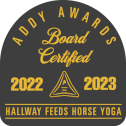Preventing Impaction Colic
Water: Essential in the Winter Horse Diet
For horses around much of the country, winter means a switch from fresh pasture to hay, as well as less daily work/exercise. This one-two punch can lead to impaction colic, which is a painful blockage in the horse’s gastrointestinal tract. However, a well-managed horse diet—along with an effort to keep horses active—can help prevent this condition.
A Change in Horse Diet
No matter what time of year it is, the horse diet centers around forage—an important source of fiber. During spring, summer, and early fall, horses satisfy this need by grazing fresh pasture. However, in late fall and winter, when pasture is unavailable, they rely on hay for the bulk of their fiber.
While good-quality hay will satisfy a horse’s fiber needs, it is naturally lower in water content than fresh pasture. Therefore, when you transition from pasture to hay, you’ll need to ensure your horse is drinking more water to stay healthy.
Winter’s Slower Pace
For many horses, winter is the “off-season,” meaning they’re getting less exercise in their daily routine. Unfortunately, this alone is enough to disrupt a horse’s digestive system, since exercise helps “keep things moving” in the gut.
Also, if a horse isn’t exercising as much as he does the rest of the year, he’s probably not working up a thirst in his daily routine. Since he’s not necessarily thirsty, he may not be drinking as much water as he does during the warmer months. Unfortunately, drinking less water is another factor that can slow down his digestive system.
When a horse’s digestive system slows down, he can be susceptible to impaction colic.
Avoiding Impaction Colic
Between the changes in a horse’s diet and daily exercise, impaction colic can be a real threat during winter. However, as a horse owner, you can help your horse avoid this through a well-managed horse diet and exercise program.
The easiest thing you have control over is ensuring access to plenty of fresh water. The importance of clean water, as part of a horse’s diet, cannot be overstated. To encourage your horse to drink it, though, you’ll need to ensure it’s not overly cold—aim for a temperature in the mid-forties to mid-fifties. The water should also be free from grain and hay. You’ll need to be vigilant in checking the trough or bucket to make sure the water remains clean and doesn’t get too cold.
In addition, you can add water to your horse’s diet by soaking hay in water. Again, the water should be clean and at a comfortable temperature.
Next, be sure to provide plenty of opportunities for your horse to move, even in winter. This can be accomplished through a nice ride, or also allowing a few hours of turnout instead of being kept in a stall.
By staying on top of your horse’s diet and exercise plan over the winter, you can help him avoid impaction colic—a payoff for which you’ll both be grateful.








